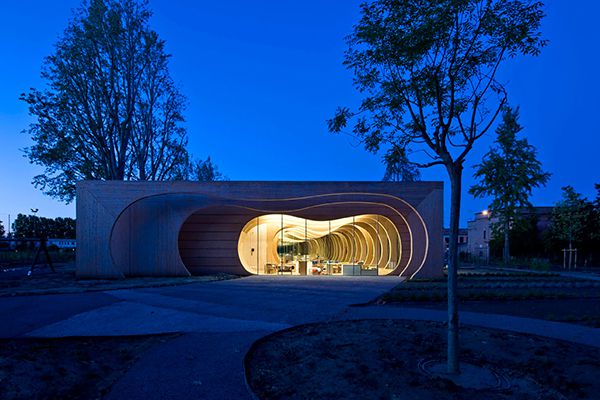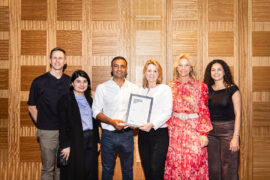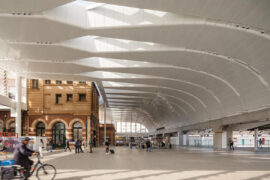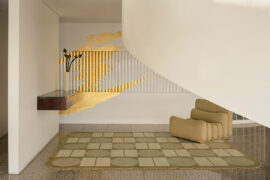Italian-architect Mario Cucinella is redefining sustainable architecture and calling for an approach he terms the Theory of Creative Empathy.

We often think of sustainable architecture as buildings that are designed to have a minimal negative environmental impact. But in reality architecture needs to consider more than just the environment in order to be sustainable, and as Italian architect Mario Cucinella proposes, it should have a positive cultural, social and economic impact and an understanding of place. Cucinella’s Theory of Creative Empathy is a holistic vision for sustainable building that takes technology and performance into account, as well as the relationship between architecture, landscape and identity. “Creativity is the idea and empathy is the way you understand a place,” says Cucinella. “Creative Empathy is the tool to transform this information into a building and create an architecture of belonging.”
In May, Cucinella delivered a series of lectures in Australia and New Zealand discussing the importance of a local, rather than global, outlook in architecture. “Sustainability is not a simple definition. There are different points of view depending where you are,” he explains. Cucinella compares sustainability with an ecosystem in that it is dependent on the characteristics of place, be it climate, culture, resources or technology. “Everywhere has different rules and a different approach. This quality of difference is our culture and more and more we understand the model of globalisation is not perfect.”
Based in Bologna, Italy, Cucinella is head of Mario Cucinella Architects (MCA) and he has designed buildings in Europe, Asia and Africa, taking people and place into consideration. One recent project is Guastalla School in Reggio Emilia, Italy, which replaces two earthquake-damaged buildings. It is inspired by the whale in the story of Pinocchio and uses natural and recycled materials in a rib-like structure that is earthquake proof and chemically safe for children.
In Ghana, the Kwame Nkrumah Presidential Library is due to be built at the edge of an artificial lake. A vast drop in water levels over the last decade has seen dead trees emerge above the surface of the water and MCA is using these in the construction of the building. “It is a good exercise to explain to the people of Ghana, a very fast-growing country, how to use a local resource because they have destroyed 80 per cent of the forest,” Cucinella explains. He describes the future library as a “piazza of knowledge” – a marketplace for the exchange of information – and says “analogies are very important in architecture. They drive you to find an architectural solution and to understand the best strategy for climate and culture.”
Cucinella established the School of Sustainability in Bologna where he encourages practicing architects to view buildings as social places. “You share them with a community,” he says. “If you don’t involve the community, they fail; and if the community doesn’t accept them, in time they are not sustainable.”
Cucinella pinpoints this as a shifting moment in sustainable architecture as people demand better quality cities. Of Sydney, he says, “there is still the need to push for the design of a new generation of buildings. Cities are contaminated with the idea of global architecture, but here the morphology of place is strong; there is still a strong character to the city.”
INDESIGN is on instagram
Follow @indesignlive
A searchable and comprehensive guide for specifying leading products and their suppliers
Keep up to date with the latest and greatest from our industry BFF's!
The new range features slabs with warm, earthy palettes that lend a sense of organic luxury to every space.

London-based design duo Raw Edges have joined forces with Established & Sons and Tongue & Groove to introduce Wall to Wall – a hand-stained, “living collection” that transforms parquet flooring into a canvas of colour, pattern, and possibility.

Welcomed to the Australian design scene in 2024, Kokuyo is set to redefine collaboration, bringing its unique blend of colour and function to individuals and corporations, designed to be used Any Way!

For Aidan Mawhinney, the secret ingredient to Living Edge’s success “comes down to people, product and place.” As the brand celebrates a significant 25-year milestone, it’s that commitment to authentic, sustainable design – and the people behind it all – that continues to anchor its legacy.

The winners of two major Powerhouse design initiatives – the Holdmark Innovation Award and the Carl Nielsen Design Accelerator – have been announced with the launch of Sydney Design Week 2025.

Now in their 19th year, the Architecture & Design Sustainability Awards are Australia’s leading program dedicated to recognising innovation and excellence in sustainable architecture and design.
The internet never sleeps! Here's the stuff you might have missed

In the latest collaboration between Designer Rugs and Greg Natale, the raw rigour of modernist geometries finds its most comforting articulation in the inherent softness of floor coverings.

From Valmont to GEYER VALMONT, Marcel Zalloua walks us through some of the milestones of what has been a fruitful, busy career in design.